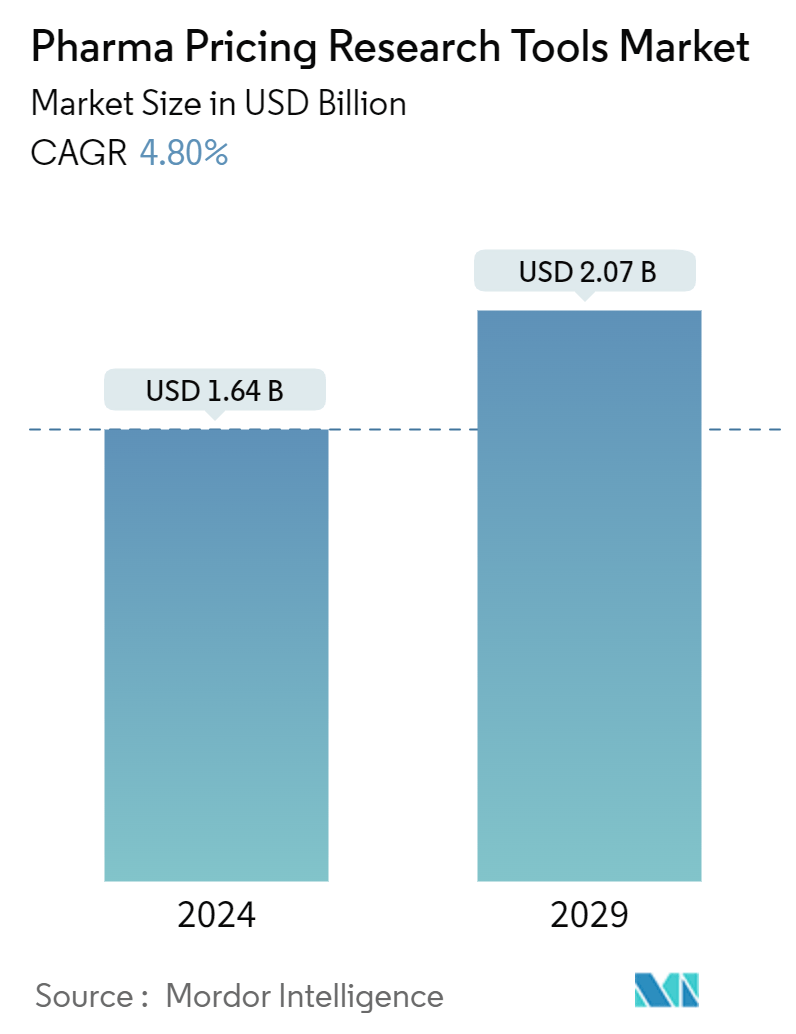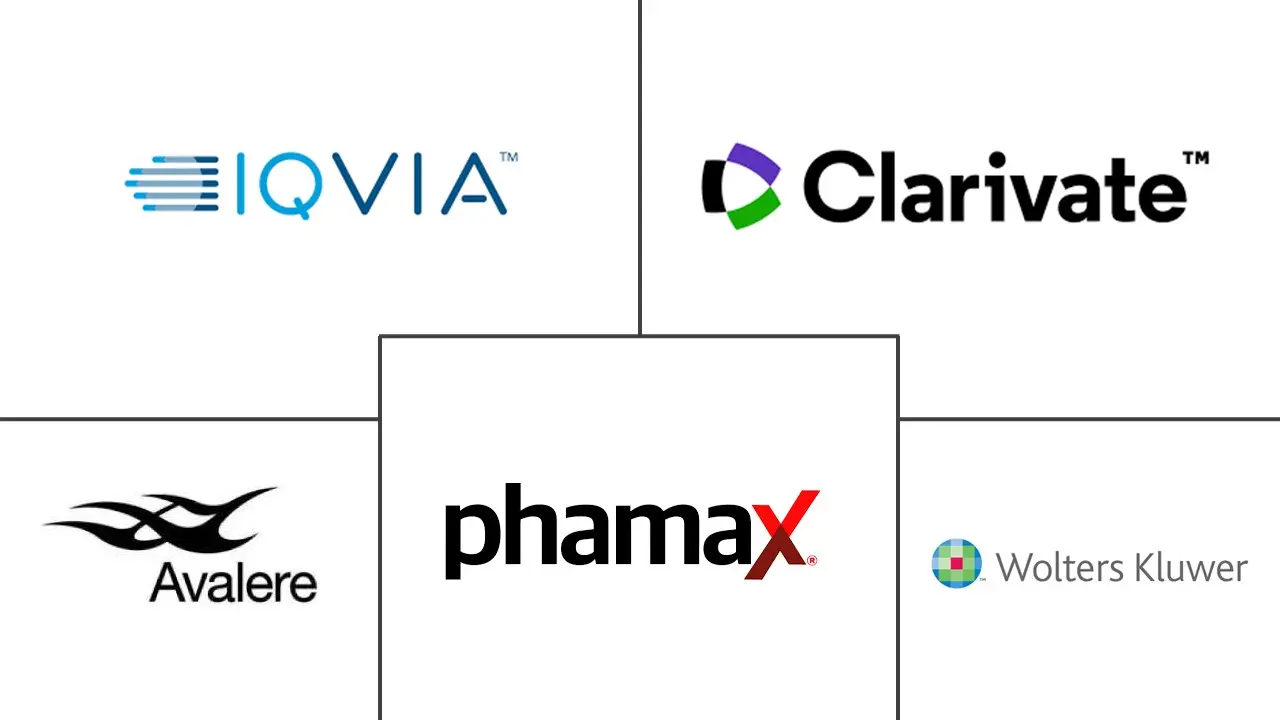Market Size of Pharma Pricing Research Tools Industry

| Study Period | 2021 - 2029 |
| Market Size (2024) | USD 1.64 Billion |
| Market Size (2034) | USD 2.07 Billion |
| CAGR (2024 - 2029) | 4.80 % |
| Fastest Growing Market | Europe |
| Largest Market | North America |
Major Players
*Disclaimer: Major Players sorted in no particular order |
Pharma Pricing Research Tools Market Analysis
The Pharma Pricing Research Tools Market size is estimated at USD 1.64 billion in 2024, and is expected to reach USD 2.07 billion by 2034, growing at a CAGR of 4.80% during the forecast period (2024-2034).
The rising demand for the complexity of pharmaceutical pricing and the growing adoption of value-based pricing is expected to boost market expansion for the pharma pricing research tools market. The pharmaceutical industry has seen a steady increase in the complexity of drug pricing and value-based pricing-related challenges. Moving away from traditional cost-based pricing, pharmaceutical companies are increasingly adopting value-based pricing models. This considers the clinical and economic value a drug delivers to patients and healthcare systems, including variable pricing across markets, and these prices depend on specific patient populations, healthcare systems, and willingness to pay. Brand-name drug prices have been increasing faster than the rate of general inflation for decades, and drug companies have increasingly relied on such price increases for revenue growth. For instance, the data published by the AARP Public Policy Institute in August 2023 shows that more than half the current list prices of the top 25 drugs have hiked since their initial release in the United States. Thus, this creates a complex pricing landscape for pharmaceuticals. The increasing price hikes of top drugs fuel the demand for pharma pricing research tools. These tools empower manufacturers to navigate the complex pricing environment and make informed decisions that will be anticipated to drive the market's growth in the forecast period.
Furthermore, value-based pricing (VBP) shifts the focus from production cost to demonstrating drug value improved patient outcomes, cost saving, and societal benefits. Pricing research tools help collect and analyze data on this aspect, creating an evidence-based value proposition. Companies need tools to measure and quantify the value of their drugs (increase lifespan cost savings). Based on proven value evidence, value-based pricing (VBP) generates data-driven reports to support negotiations with payers. For instance, in an article published by JAMA Health Forum in December 2022, value-based pricing (VBP) successfully met cost-effectiveness benchmarks, with prices reflecting the value delivered in terms of quality-adjusted life-year gained, staying below USD 100,000 and USD 150,000 per Quality-Adjusted Life-Year (QALY). Manufacturers' focus on value-based pricing increased the demand for the pharma pricing research tools market over the study period.
Due to the aforementioned factors, such as the increasing demand for the complexity of pharmaceutical pricing and the rising adoption of value-based pricing, the market is expected to continue to grow in the coming years.
However, in underdeveloped countries, the lack of standardization in various aspects of healthcare data and hurdles in the adoption and effectiveness of pharma pricing research tools will hinder the market growth in the forecast period.
Pharma Pricing Research Tools Industry Segmentation
As per the scope of the report, pharma pricing research tools are specialized software applications or databases that help pharmaceutical companies gather and analyze data to inform their pricing decisions. The pharma pricing research tools market is segmented by application, type, and geography. By application, the market is segmented into prescription drugs and over-the-counter drugs. By type, the market is segmented into market-based, value-based, and cost-based pricing. The market is segmented by geography into North America, Europe, and the Rest of the World. The report offers the value (in USD) for the above segments.
| By Application | |
| Prescription Drugs | |
| Over-the-counter Drugs |
| By Type | |
| Market-Based Pricing | |
| Value-Based Pricing | |
| Cost-based pricing |
| Geography | ||||||||
| ||||||||
| ||||||||
| Rest of the World |
Pharma Pricing Research Tools Market Size Summary
The pharma pricing research tools market is poised for significant growth, driven by the increasing complexity of pharmaceutical pricing and the shift towards value-based pricing models. As pharmaceutical companies move away from traditional cost-based pricing, they are adopting strategies that consider the clinical and economic value of drugs, which includes variable pricing across different markets and patient populations. This shift is necessitated by the rising costs of brand-name drugs, which have been outpacing general inflation, creating a complex pricing landscape. The demand for pharma pricing research tools is further fueled by the need to navigate these complexities and make informed pricing decisions. These tools are essential for collecting and analyzing data to support value-based pricing, which focuses on demonstrating improved patient outcomes and cost savings. The adoption of emerging technologies like AI and big data analytics is also transforming the pricing landscape, providing deeper insights into consumer behavior and market trends, thereby enhancing the decision-making process for pharmaceutical companies.
North America is expected to hold a significant share of the pharma pricing research tools market due to its high R&D expenditure, stringent regulations, and the complex pricing environment. The region's pharmaceutical companies require advanced tools to manage diverse pricing strategies and ensure compliance with regulatory requirements. The Inflation Reduction Act in the United States, which allows Medicare to negotiate drug prices and mandates rebates for excessive price increases, adds to the complexity of drug pricing, further driving the demand for these tools. In Canada, rising drug costs and government regulations aimed at reducing prices also contribute to the market's growth. The market is moderately consolidated, with key players like IQVIA, Clarivate Analytics, and others focusing on expanding their presence globally. The competitive landscape is shaped by the need for specialized pricing tools to address the challenges posed by high drug prices and regulatory pressures, ensuring that pharmaceutical companies can justify their pricing strategies and remain competitive in the market.
Pharma Pricing Research Tools Market Size - Table of Contents
-
1. MARKET DYNAMICS
-
1.1 Market Overview
-
1.2 Market Drivers
-
1.2.1 Increasing Complexity of Pharmaceutical Pricing
-
1.2.2 Rising Demand for Pricing Research & Analytics in Healthcare
-
-
1.3 Market Restraints
-
1.3.1 Lack of Standardization in Underdeveloped Countries
-
-
1.4 Porter's Five Force Analysis
-
1.4.1 Threat of New Entrants
-
1.4.2 Bargaining Power of Buyers/Consumers
-
1.4.3 Bargaining Power of Suppliers
-
1.4.4 Threat of Substitute Products
-
1.4.5 Intensity of Competitive Rivalry
-
-
-
2. MARKET SEGMENTATION (Market Size by Value - USD)
-
2.1 By Application
-
2.1.1 Prescription Drugs
-
2.1.2 Over-the-counter Drugs
-
-
2.2 By Type
-
2.2.1 Market-Based Pricing
-
2.2.2 Value-Based Pricing
-
2.2.3 Cost-based pricing
-
-
2.3 Geography
-
2.3.1 North America
-
2.3.1.1 United States
-
2.3.1.2 Canada
-
2.3.1.3 Mexico
-
-
2.3.2 Europe
-
2.3.2.1 Germany
-
2.3.2.2 United Kingdom
-
2.3.2.3 France
-
2.3.2.4 Italy
-
2.3.2.5 Spain
-
2.3.2.6 Rest of Europe
-
-
2.3.3 Rest of the World
-
-
Pharma Pricing Research Tools Market Size FAQs
How big is the Pharma Pricing Research Tools Market?
The Pharma Pricing Research Tools Market size is expected to reach USD 1.64 billion in 2024 and grow at a CAGR of 4.80% to reach USD 2.07 billion by 2034.
What is the current Pharma Pricing Research Tools Market size?
In 2024, the Pharma Pricing Research Tools Market size is expected to reach USD 1.64 billion.

